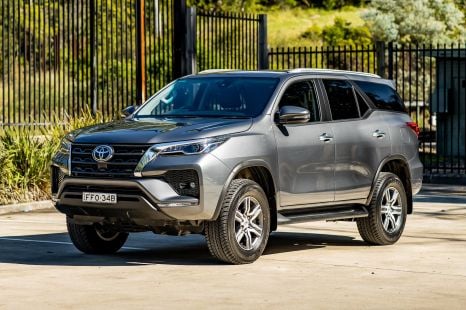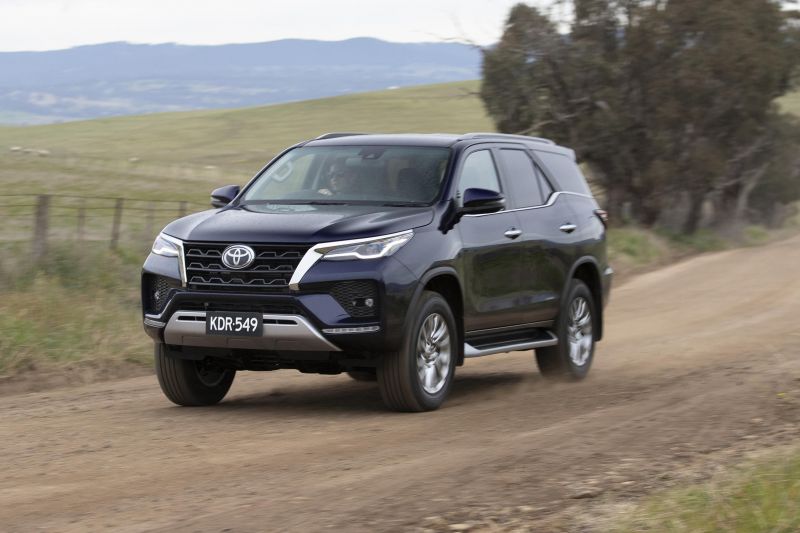

Matt Campbell
2025 Toyota Fortuner GXL review
3 Months Ago
The 2025 Toyota Fortuner remains unchanged compared to previous years. While the SUV has been a popular model in other markets, it has not achieved the same level of success in Australia compared to its ute-based sibling.
Despite sharing similar mechanicals and bearing the Toyota badge, the Fortuner is substantially outsold by the Ford Everest.
One potential factor affecting the Fortuner's popularity is the presence of the Toyota LandCruiser Prado in the same segment. The Prado, for a higher price, offers a more refined cabin, a distinct design, and a larger, more comfortable interior. With the introduction of a new Prado model, the differences between the two vehicles are expected to increase further.
Quickly see how this car stacks up against its competition. Select any benchmark to see more details.
Where expert car reviews meet expert car buying – CarExpert gives you trusted advice, personalised service and real savings on your next new car.
| Configuration | Price From* |
|---|---|
| 2.8L, 6-speed auto, 5-door SUV, Diesel, 4x4 | $53,775 |
| Configuration | Price From* |
|---|---|
| 2.8L, 6-speed auto, 5-door SUV, Diesel, 4x4 | $58,895 |
| Configuration | Price From* |
|---|---|
| 2.8L, 6-speed auto, 5-door SUV, Diesel, 4x4 | $66,755 |
Where expert car reviews meet expert car buying – CarExpert gives you trusted advice, personalised service and real savings on your next new car.
See our comprehensive details for the Toyota Fortuner
Toyota doesn’t actually quote a boot capacity figure for the Fortuner, but independent figures quote 200L with the third row in use, 716L with the third row folded, and 1080L with the second row folded. As you can see from the images, it’s quite hindered by those rear seats when they’re not in use.
You also get a full-size spare wheel, which is an 18-inch alloy unit in the Crusade and 17-inch steel unit in lower grades.
Where expert car reviews meet expert car buying – CarExpert gives you trusted advice, personalised service and real savings on your next new car.
CarExpert High Resolution Photos of the Toyota Fortuner


Unlike most ute-based SUVs, which often carry over their commercial vehicle interiors, the Toyota Fortuner features distinct design elements compared to the HiLux. While the steering wheel, buttons, and controls are generally the same, the Fortuner has a more car-like cockpit, featuring a better-integrated touchscreen and an upright centre stack that blends elements of both the HiLux and Prado designs.
The Fortuner's interior includes more upmarket materials, such as padded surfaces with stitched elements on the dashboard, around the centre console, and atop the instrument cluster. However, several components are carried over from the HiLux, including the telescopically adjustable multifunction steering wheel, gear shifter, 4x4 dial, climate control cluster, front tweeters near the side mirrors, and A-pillar grab handles.
Some aspects of the Fortuner’s design, such as the gated automatic shifter, manual handbrake, and woodgrain trim, reflect its older platform. The vehicle is less digitised compared to newer models like the next-generation Prado.
In the second row, space is adequate, with good legroom but more limited headroom and toe room. Roof-mounted air vents, cup holders, a coat hook, foldable grab handles, and power outlets (12V and 220V) are provided, along with map pockets, a fold-out centre armrest, and ISOFIX anchors for child seats.
The third-row seats are smaller and more suited for children. When not in use, these seats fold into the sides of the boot, limiting both cargo space and rear-quarter visibility. Toyota does not provide an official boot capacity for the Fortuner, but independent measurements suggest 200L with the third row in use, 716L with the third row folded, and 1080L with the second row folded.
The Fortuner comes with a full-size spare wheel, which is an 18-inch alloy unit on the Crusade variant and a 17-inch steel unit on lower grades.
The Fortuner retains analogue dials, which add a touch of color compared to the HiLux, while the multifunction display offers essential information but reflects older Toyota and Lexus designs. The central infotainment system uses older software, providing wired Apple CarPlay and Android Auto, and runs on slower hardware compared to competitors like the Ford Everest. Physical buttons and dials for shortcuts and controls are included, making the system easy to use. The infotainment system also features embedded navigation, DAB digital radio (available in GXL and Crusade variants), and some Toyota Connected Services, such as myToyota app access, Stolen Vehicle Tracking, Automatic Collision Notification, and SOS Emergency Call.
There are 1 different fuel economy figures for the Toyota Fortuner
The most fuel efficient Toyota Fortuner is the Crusade with a 6-speed Automatic which is powered by a 2.8L TURBO DIESEL COMMON RAIL and uses 7.6L of diesel per 100km on the combined cycle.
| Toyota Fortuner | Fuel Type | Combined |
|---|---|---|
| 2.8L, 6-speed auto, 5-door SUV, Diesel, 4x4 | Diesel | 7.6 L/100km |
What are the running and servicing costs of a Toyota Fortuner?
The Fortuner is covered by a five-year, unlimited-kilometre warranty. The Fortuner still has six-month/10,000km intervals, which is quite a bit shorter than most rivals.
Toyota offers five years-worth of capped price servicing, with each visit costing $290 a pop – or $2900 for five years.
Our expert take on Toyota Fortuner drivability.
The Toyota Fortuner starts with the characteristic sound of a diesel engine, giving it a more utilitarian feel compared to models like the Ford Everest. The engine noise is present but reasonably subdued, while the vehicle's controls reflect its older design and origins in the commercial vehicle segment.
Equipped with a 2.8-litre four-cylinder turbo-diesel engine delivering 500Nm of torque (a tune introduced in 2020), the Fortuner remains competitive in its segment, comparable to models like the Ford Everest Bi-Turbo and offering more power on paper than the Isuzu MU-X. The engine, shared with the HiLux, LandCruiser Prado, and HiAce, works with a six-speed automatic transmission to provide smooth and strong acceleration.
In urban driving, the Fortuner exhibits a relaxed driving dynamic typical of ladder-frame 4WD vehicles. While the engine can become louder under heavy acceleration, it has sufficient power for highway speeds and overtaking. In recent testing, the Fortuner outperformed most of its direct four-cylinder diesel competitors, with the exception of the Ford Everest Bi-Turbo.
The hydraulic steering is heavy, making it less suited for city driving and parking, though it offers accurate feedback. The Crusade trim includes a 360-degree camera, which aids in maneuvering the 4795mm long vehicle in tighter spaces. Visibility is generally good, thanks to large mirrors and windows.
On the open road, the Fortuner feels more at ease, utilizing its torque-rich engine for long-distance driving. The diesel engine operates quietly in higher gears, and road noise is well managed, although wind noise from the large side mirrors can be noticeable. Fuel consumption improves significantly on highways, but the lack of idle stop-start technology means urban driving can increase fuel consumption to over 10L/100km.
At higher speeds, the steering can feel vague, particularly around the center, requiring frequent small adjustments to keep the vehicle on course. This characteristic is also present in other heavy-duty Toyota models.
While the Fortuner has received updates to its safety systems, its technology suite lags behind competitors like the Ford Everest and Isuzu MU-X. The lane keep assist, which operates through braking, can be overly aggressive, causing the vehicle to veer when it detects a potential lane departure. The Lane Trace Assist, designed to keep the vehicle centered in the lane, tends to make constant corrections, which can be unsettling for the driver. Blind-spot monitoring and rear cross-traffic alert are available, though they are limited to the Crusade trim.
Off-road, the Fortuner demonstrates its capabilities, performing well in traction tests. In 4H mode, it navigates challenging conditions with minimal effort, showing strong body rigidity during flex tests. The vehicle handles difficult terrain effectively, even with highway tires, and performs well in low-range driving with the rear differential unlocked.
What is the warranty on a Toyota Fortuner?
The Toyota Fortuner offers a 5 year unlimited km warranty. This is separate to the warranty on offer under Australian Consumer Law which can be greater for certain parts based on what is deemed as a reasonable period of time.
Is this the right car for you? Out experts buy or not guide.
The top-spec Toyota Fortuner is built on a reliable platform and benefits from Toyota’s reputation for dependability. It offers a more compact alternative to the Prado, making it more suitable for city driving.
However, the Fortuner does not match some segment benchmarks in terms of power and practicality. Its technology is also lagging behind more modern competitors. The driving experience can feel heavy, and the vehicle lacks the refinement seen in other models.
The release of the all-new Prado is expected to highlight these differences further. With a major update, including a potential migration to the TNGA-F platform, the Fortuner could address its current shortcomings and become more competitive within the segment.
Where expert car reviews meet expert car buying – CarExpert gives you trusted advice, personalised service and real savings on your next new car.
The cheapest Toyota Fortuner is the GX that starts from $53,775.
The most expensive Toyota Fortuner is the Crusade that starts from $66,755.
The best towing capacity of a Toyota Fortuner is 3100 kg offered by the following variants: GX, GXL and Crusade.
The largest Toyota Fortuner is the GXL which measures 1855mm wide, 4795mm in length and sits 1835mm tall.
The most powerful Toyota Fortuner is the GXL which has 150kW of power from its 2.8L TURBO DIESEL COMMON RAIL engine.
The {modelTitle} is manufactured in different countries, depending on the variant, then shipped to Australia. The Toyota Fortuner may be manufactured in .
The heaviest Toyota Fortuner is the GXL which weighs 2800 kg (kerb weight).
The Toyota Fortuner uses diesel.